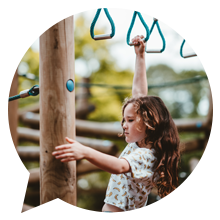Wooden play equipment

Materials and material life
Timber deteriorates most when buried in, or in contact with, the ground. EN 1176 and good design of play equipment helps to extend equipment life, but without effective measures the lifespan of in-ground timbers can be limited.
Timber will not rot when its moisture content is below approximately 20% for most of the time. In the UK this applies to timber out of contact with the ground. However, junctions between components, holes for fastenings and horizontal parts from which water is not easily shed can be at risk as they will maintain a higher than average moisture content. Design to reduce these problems is therefore important. Water is also much more likely to get into wood through the end grain. Exposed areas of end grain should be protected wherever possible. On verticals use top covers, or sloping surfaces to shed water.
In practice most solid timber in playground equipment is softwood, such as pine, larch, spruce and Douglas fir and is treated with wood preservative. The preservative penetrates into the material and is normally applied by a vacuum treatment process. Except for very small cut or drilled areas, DIY application is not really acceptable.
The preservative should be permanent, insoluble in water, safe, clean and compatible with finishes etc. The use of CCA in new equipment has been banned. The ban is not retrospective and there is no need to make any changes to existing play equipment. RoSPA has no evidence of any safety problems with the use of CCA. On new equipment the supplier should confirm that the wood has been treated in accordance with the requirements of DEFRA
As the treatment only penetrates a few millimetres all cut and drilled areas, which might expose untreated wood should be treated by hand brushing to prevent untreated wood coming into contact with water. Playground equipment is left at least 14 days after treatment before use to allow salts to fix. Any white powder should be washed off.
Cracking in timber
Wood is a natural material and cracking is natural. Normally these will have no appreciable effect on the strength of the material. They should not exceed 10mm wide (in which case they can be a "finger trap" as defined by EN 1176) or are places where water can remain and soak into the wood. Cracks normally appear due to a differential rate of drying out of wet wood. If wood which has a similar moisture content to the natural surrounding is used, cracking is greatly reduced. The preservative treatment greatly increases the moisture level in the wood. In order to ensure that the preservative penetrates into drilled holes etc., many manufacturers will wait until they receive an order before making up finished equipment.
They can then treat all exposed areas. However this means that the outside of the wood has high moisture content. If this can be allowed to dry out slowly in more controlled conditions, often taking up to three months, the end result will be a greatly reduced incidence of cracking. Discuss this with your supplier. Patience in waiting for installation, or ordering at the right time (so installation takes place between October and March when equipment is unlikely to be subject to rapid drying) can make an amazing difference. Equipment which is installed only a few days after pressure treatment and in hot summer conditions will invariably split and crack badly.
Wood based sheet materials
Often equipment includes panels etc. made from plywood or similar laminates. Marine plywood or pressure treated plywood to BS EN 636, part 3 should be used. The edges of plywood are vulnerable to wetting and edges should be treated with an appropriate edge sealant.
Metal fixings
Some form of metal fixing is common on play equipment. This is normally in the form of bolts and screws (nails are not recommended). Preservative may accelerate any metal corrosion resulting from exposed wet metal and thus the use of either hot dipped galvanised, or stainless steel fastenings are recommended. Where nails are used (perhaps on floor boards) annular or other improved shank nails are essential to prevent them working loose or being pulled free. Ordinary nails are not acceptable.
Wet and dry rot
Dry rot is a misnomer. It requires moisture, although at very specific levels (between 20 and 25%). These levels are common in play equipment and dry rot can be a problem. Wet rot, as its name implies also needs moisture and is most likely around ground contact points and joints (or in cracks).
They are prevented by preservative, so it is untreated areas of wood, or ground contact points which are at risk. It can remain invisible until late in its development. It is quite possible to find a beam whose exterior (treated wood) is intact, but whose middle (untreated) is rotten. Often the first that anyone knows about the rot is when the wood breaks, with possible dangerous consequences.
It is essential to inspect the wood regularly. Unsoundness can often be detected by the hollow sound made when the area is tapped (a rubber mallet is good for this). Use a sharp pointed instrument (say a fine bladed electrician's screwdriver) to probe the wood. If decay is thought possible, prise up small splinters with a knife. If they break off with a brittle fracture, it is likely that decay is present. Replace infected members.
Further information
Relevant British Standards are: BS EN 636, part 3 and BS4079 (Plywood), BS5268 (Timber), BS5589 (Preservative), BS EN 1176 ( Equipment Standards)
The Timber Research and Development Association, Stocking Lane, Hughenden Valley, High Wycombe, Bucks HP14 4ND, 01494 563091, produce Information Sheets. WIS 2/3-1Finishes for exterior timber, WIS 2/3-10 Timbers - their properties and uses, WIS 2/3-11 Specification and treatment of exterior plywood, WIS 2/3-16 Preservative treatment for timber - a guide to specification, WIS 2/3-21 Wood preservation - processing and control, WIS 2/3-28 Introducing Wood, 0-13 Timber in Playground Equipment.